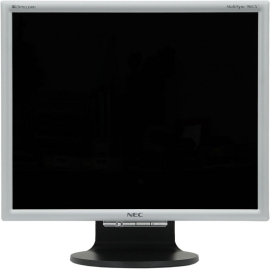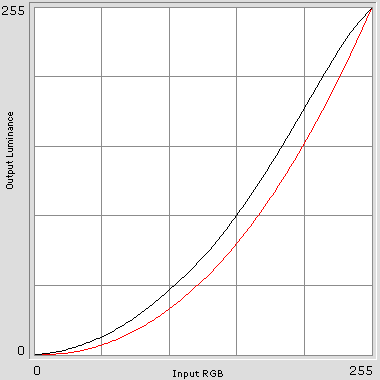LCD MONITOR REVIEW NEC MULTISYNC 90GX2 19 INCH
![]()
|
|
 |
||||||||||||
| Posted:2006-07-08 By lcd monitor Number of View:98835 |
|||||||||||||
By :lcd monitor Posted:2006-07-08
NEC MultiSync 90GX2
The outward appearance of the MultiSync 90GX2 is very much alike to the 1970GX: it has a similar-looking silver-and-black case, which is large but has smoothed-out corners unlike NEC’s older models. Like the previous model, this one uses a glossy-coated matrix.
The side view hasn’t changed much, though. The back panel of the case is totally rounded and the stand has been simplified. It now only allows changing the tilt of the screen. The height of the screen remains constant at 95 millimeters above the desk surface.
The lcd monitor has analog and digital inputs, and a 4-port USB hub. The power adapter is integrated into the case.
The controls are the same as in the previous model: a 4-position joystick and four buttons, including a Power button (the Reset button is but rarely used in the menu, but instead works as a switch between the DV Modes). Talking about DV Mode, sometimes this feature is wrongly considered as an equivalent to the brightness/contrast presets in other manufacturers’ lcd monitors. The difference is that DV Mode affects the gamma compensation value rather than the brightness setting, which results in a lighter or higher-contrast image. This function is meant for movies and games, but not for work. Changing the gamma correction distorts the reproduction of colors up to a total loss of the darkest or lightest image tones.
The lcd monitor’s menu doesn’t differ much from the previous model’s. The lcd monitor has 100% brightness and 50% contrast by default. To achieve 100-nit brightness of white I chose 25% brightness and 28% contrast. Color gradients are reproduced well at the default settings, but solid-color bands become discernable in them at reduced values of contrast. They are not very conspicuous, though. The backlighting is normal, but you can see in the dark that the top and bottom of the screen are a little lighter than the middle.
The gamma curves look almost the same as they did on the 1970GX, except that the gamma value is a little lower than necessary, making the image somewhat whitish. The drawback I noticed with the 1970GX – its overstated default contrast – can be observed here, too. You can cure this by lowering the contrast setting in the lcd monitor’s menu from 50% to 45% or even a little lower.
The lcd monitor’s color temperature modes are set up well for its class, except for cold tones: the temperature of white is lower than that of different levels of gray when you select 7500K or higher. The sRGB mode gives you a perfect setup, though.
The lcd monitor uses a TN+Film matrix with response time compensation. Its speed is overall good, except for a few transitions between light tones that may take as long as 21 milliseconds. The averaged response time is 5.9 milliseconds, which is higher than the BenQ FP93GX’s, but the specified response time of the 90GX2 is higher, too.
There are RTC artifacts, but not too serious. The average error amounts to 11.7% with two peaks of 70% (on light tones, when transitioning from the lighter to the darker tone).
The lcd monitor has an excellent contrast ratio and an even higher maximum brightness than the 1970GX has. So, I can’t have any complaints about its brightness/contrast characteristics. Thus, the NEC MultiSync 90GX2 is a worthy successor to the 1970GX, with similar characteristics, but a considerably lower response time. Unfortunately, the stand has been simplified in comparison with the 1970GX and now doesn’t allow adjusting the height of the screen. This lcd monitor is equally suitable for gamers and home users who want to have a good-quality and well-configured product. The only thing that may set you aback is the lcd monitor’s price of over $500. This sum can buy you a good lcd monitor on a PVA or MVA matrix with RTC which is going to be better than the 90GX2 with its TN+Film matrix in every parameter except for response time. You can also buy an inexpensive 20” lcd monitor on TN+Film for this money. For example, the rather good lcd monitor Acer AL2017 with a 1400x1050 matrix has a considerably lower price than the mentioned $500.
we would be happy to answer for your question . if you have suggestion or comment
regarding this review our support would be glad to help just join our forum and ask u will get the best answer
to discuss check our forum section :-) RATE THIS REVIEW | |||||||||||||
![]()

7600gt review
7600gt is the middle card range.
We already benchmarked this video card and found that ...

 geforce 8800gtx and 8800gts
geforce 8800gtx and 8800gts  Xtreview software download Section
Xtreview software download Section  AMD TURION 64 X2 REVIEW
AMD TURION 64 X2 REVIEW  INTEL PENTIUM D 920 , INTEL PENTIUM D 930
INTEL PENTIUM D 920 , INTEL PENTIUM D 930  6800XT REVIEW
6800XT REVIEW  computer hardware REVIEW
computer hardware REVIEW  INTEL CONROE CORE DUO 2 REVIEW VS AMD AM2
INTEL CONROE CORE DUO 2 REVIEW VS AMD AM2  INTEL PENTIUM D 805 INTEL D805
INTEL PENTIUM D 805 INTEL D805  Free desktop wallpaper
Free desktop wallpaper  online fighting game
online fighting game  Xtreview price comparison center
Xtreview price comparison center 

- The new version of GPU-Z finally kills the belief in the miracle of Vega transformation
- The motherboard manufacturer confirms the characteristics of the processors Coffee Lake
- We are looking for copper coolers on NVIDIA Volta computing accelerators
- Unofficially about Intels plans to release 300-series chipset
- The Japanese representation of AMD offered monetary compensation to the first buyers of Ryzen Threadripper
- This year will not be released more than 45 million motherboards
- TSMC denies the presentation of charges from the antimonopoly authorities
- Radeon RX Vega 64 at frequencies 1802-1000 MHz updated the record GPUPI 1B
- AMD itself would like to believe that mobile processors Ryzen have already been released
- AMD Vega 20 will find application in accelerating computations
- Pre-orders for new iPhone start next week
- Radeon RX Vega 57, 58 and 59: the wonders of transformation
- ASML starts commercial delivery of EUV-scanners
- The older Skylake processors with a free multiplier are removed from production
- Meizu will release Android-smartphone based on Helio P40
- AMD Bristol Ridge processors are also available in American retail
- The fate of Toshiba Memory can be solved to the next environment
- duo GeForce GTX 1080 Ti in GPUPI 1B at frequencies of 2480-10320 MHz
- New Kentsfield overclocking record up to 5204 MHz
- Lenovo released Android-smartphone K8



computer news computer parts review Old Forum Downloads New Forum Login Join Articles terms Hardware blog Sitemap Get Freebies











